Business Economics Report: Micro and Macro Analysis - Apple & Roaming
VerifiedAdded on 2022/09/02
|8
|1250
|10
Report
AI Summary
This report delves into the application of microeconomic and macroeconomic principles, using Apple as a case study for microeconomic analysis, focusing on its pricing strategies, price elasticity of demand, and the impact of product launches on revenue. The report examines factors affecting demand, responsiveness to price changes, and the concept of a perfectly competitive market. For macroeconomic analysis, the report investigates the effects of data roaming charges on consumer and producer surplus, and it discusses data roaming charges as a form of market failure. The analysis includes calculations of price elasticity and revenue changes, illustrating the relationship between pricing strategies and market outcomes. The report aims to evaluate how changes in strategies can affect businesses and market functioning in correspondence to the core economic principles.
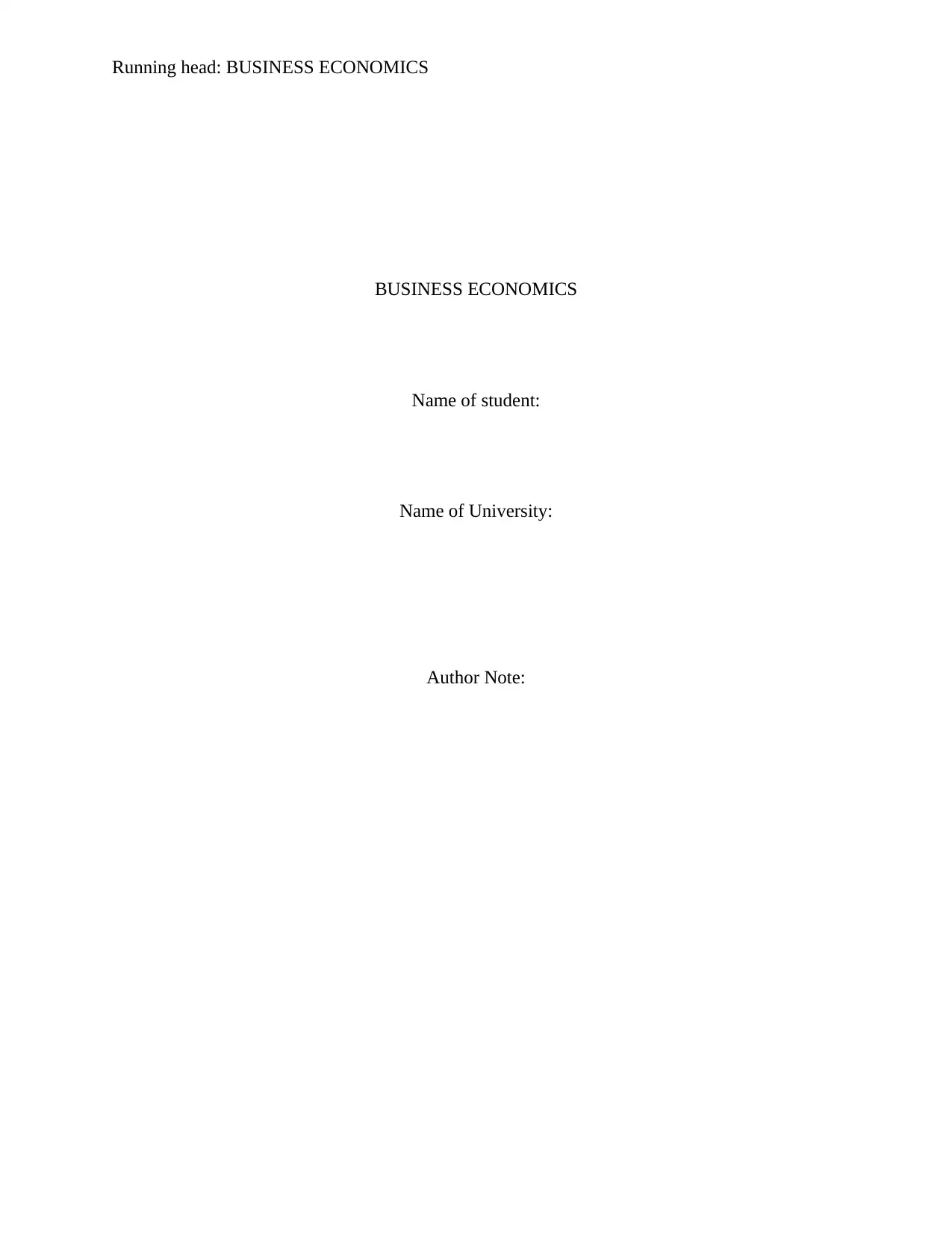
Running head: BUSINESS ECONOMICS
BUSINESS ECONOMICS
Name of student:
Name of University:
Author Note:
BUSINESS ECONOMICS
Name of student:
Name of University:
Author Note:
Paraphrase This Document
Need a fresh take? Get an instant paraphrase of this document with our AI Paraphraser
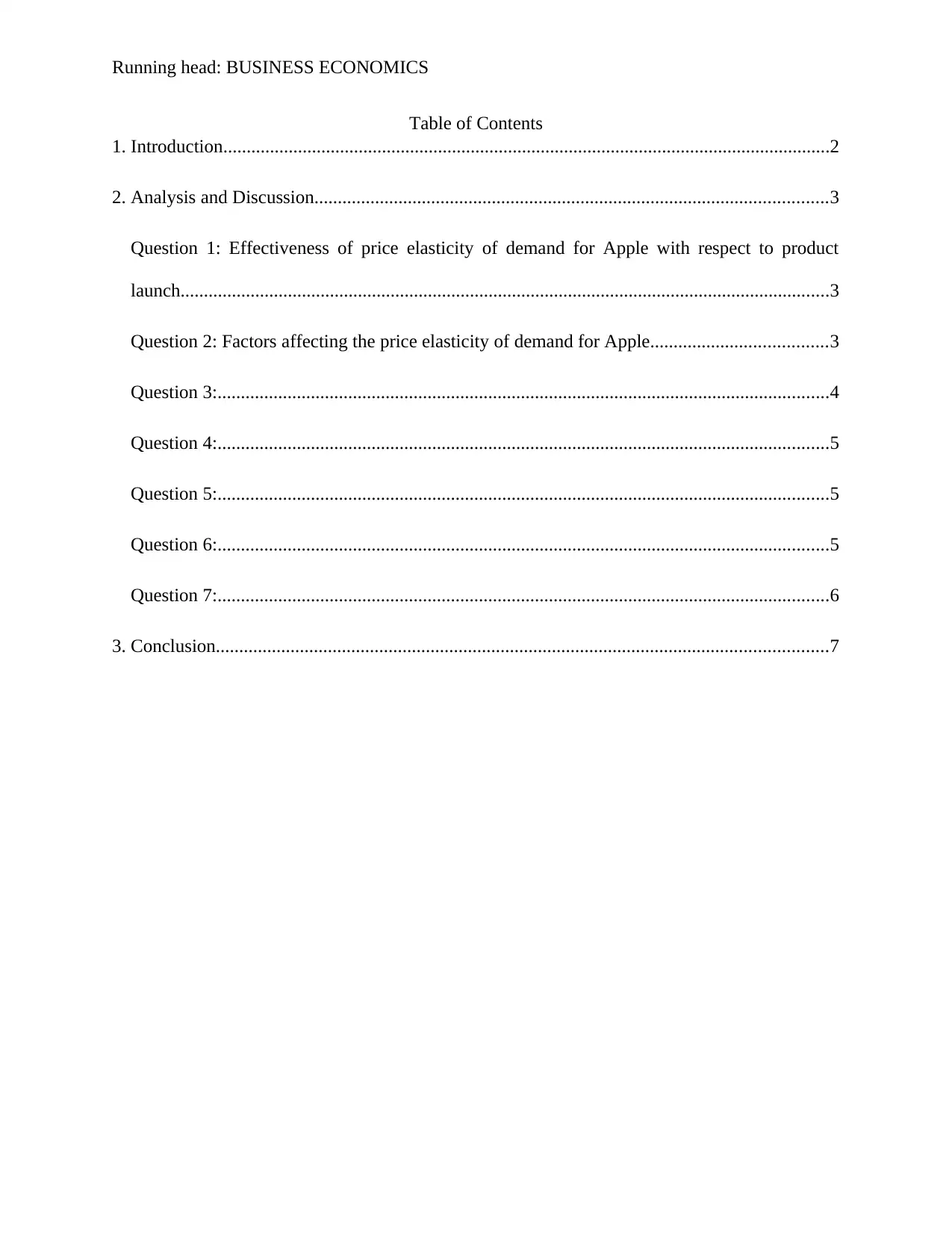
Running head: BUSINESS ECONOMICS
Table of Contents
1. Introduction..................................................................................................................................2
2. Analysis and Discussion..............................................................................................................3
Question 1: Effectiveness of price elasticity of demand for Apple with respect to product
launch...........................................................................................................................................3
Question 2: Factors affecting the price elasticity of demand for Apple......................................3
Question 3:...................................................................................................................................4
Question 4:...................................................................................................................................5
Question 5:...................................................................................................................................5
Question 6:...................................................................................................................................5
Question 7:...................................................................................................................................6
3. Conclusion...................................................................................................................................7
Table of Contents
1. Introduction..................................................................................................................................2
2. Analysis and Discussion..............................................................................................................3
Question 1: Effectiveness of price elasticity of demand for Apple with respect to product
launch...........................................................................................................................................3
Question 2: Factors affecting the price elasticity of demand for Apple......................................3
Question 3:...................................................................................................................................4
Question 4:...................................................................................................................................5
Question 5:...................................................................................................................................5
Question 6:...................................................................................................................................5
Question 7:...................................................................................................................................6
3. Conclusion...................................................................................................................................7
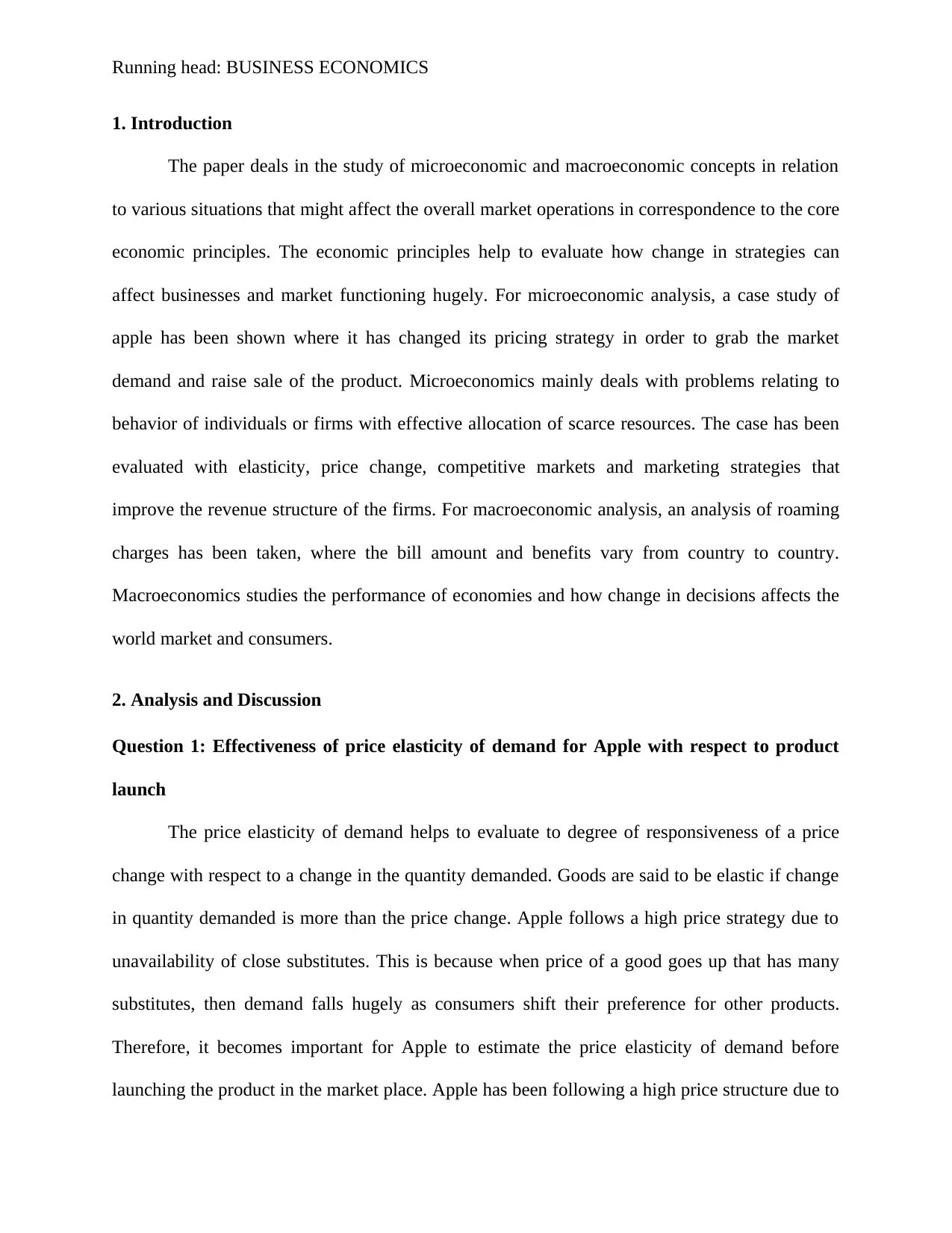
Running head: BUSINESS ECONOMICS
1. Introduction
The paper deals in the study of microeconomic and macroeconomic concepts in relation
to various situations that might affect the overall market operations in correspondence to the core
economic principles. The economic principles help to evaluate how change in strategies can
affect businesses and market functioning hugely. For microeconomic analysis, a case study of
apple has been shown where it has changed its pricing strategy in order to grab the market
demand and raise sale of the product. Microeconomics mainly deals with problems relating to
behavior of individuals or firms with effective allocation of scarce resources. The case has been
evaluated with elasticity, price change, competitive markets and marketing strategies that
improve the revenue structure of the firms. For macroeconomic analysis, an analysis of roaming
charges has been taken, where the bill amount and benefits vary from country to country.
Macroeconomics studies the performance of economies and how change in decisions affects the
world market and consumers.
2. Analysis and Discussion
Question 1: Effectiveness of price elasticity of demand for Apple with respect to product
launch
The price elasticity of demand helps to evaluate to degree of responsiveness of a price
change with respect to a change in the quantity demanded. Goods are said to be elastic if change
in quantity demanded is more than the price change. Apple follows a high price strategy due to
unavailability of close substitutes. This is because when price of a good goes up that has many
substitutes, then demand falls hugely as consumers shift their preference for other products.
Therefore, it becomes important for Apple to estimate the price elasticity of demand before
launching the product in the market place. Apple has been following a high price structure due to
1. Introduction
The paper deals in the study of microeconomic and macroeconomic concepts in relation
to various situations that might affect the overall market operations in correspondence to the core
economic principles. The economic principles help to evaluate how change in strategies can
affect businesses and market functioning hugely. For microeconomic analysis, a case study of
apple has been shown where it has changed its pricing strategy in order to grab the market
demand and raise sale of the product. Microeconomics mainly deals with problems relating to
behavior of individuals or firms with effective allocation of scarce resources. The case has been
evaluated with elasticity, price change, competitive markets and marketing strategies that
improve the revenue structure of the firms. For macroeconomic analysis, an analysis of roaming
charges has been taken, where the bill amount and benefits vary from country to country.
Macroeconomics studies the performance of economies and how change in decisions affects the
world market and consumers.
2. Analysis and Discussion
Question 1: Effectiveness of price elasticity of demand for Apple with respect to product
launch
The price elasticity of demand helps to evaluate to degree of responsiveness of a price
change with respect to a change in the quantity demanded. Goods are said to be elastic if change
in quantity demanded is more than the price change. Apple follows a high price strategy due to
unavailability of close substitutes. This is because when price of a good goes up that has many
substitutes, then demand falls hugely as consumers shift their preference for other products.
Therefore, it becomes important for Apple to estimate the price elasticity of demand before
launching the product in the market place. Apple has been following a high price structure due to
⊘ This is a preview!⊘
Do you want full access?
Subscribe today to unlock all pages.

Trusted by 1+ million students worldwide
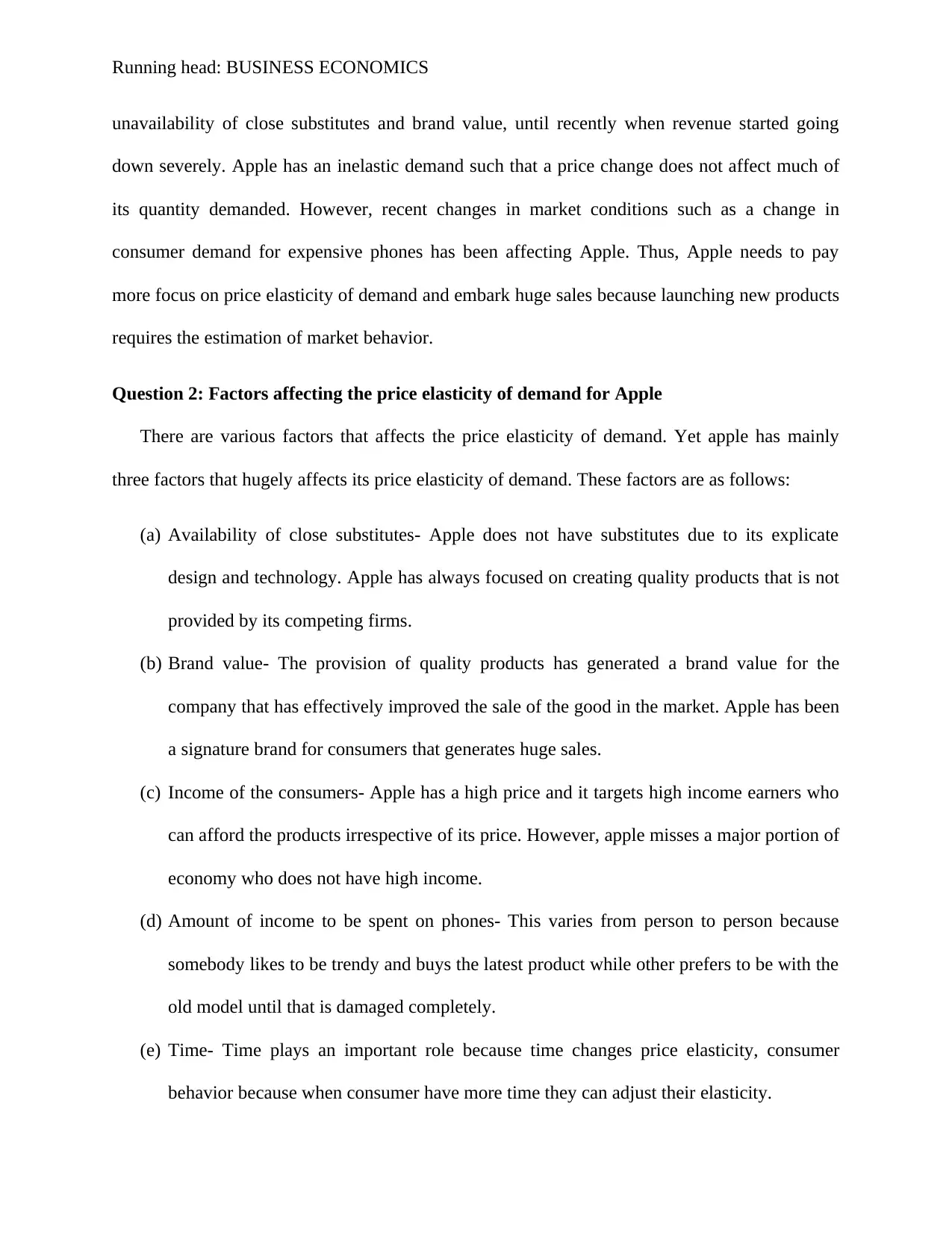
Running head: BUSINESS ECONOMICS
unavailability of close substitutes and brand value, until recently when revenue started going
down severely. Apple has an inelastic demand such that a price change does not affect much of
its quantity demanded. However, recent changes in market conditions such as a change in
consumer demand for expensive phones has been affecting Apple. Thus, Apple needs to pay
more focus on price elasticity of demand and embark huge sales because launching new products
requires the estimation of market behavior.
Question 2: Factors affecting the price elasticity of demand for Apple
There are various factors that affects the price elasticity of demand. Yet apple has mainly
three factors that hugely affects its price elasticity of demand. These factors are as follows:
(a) Availability of close substitutes- Apple does not have substitutes due to its explicate
design and technology. Apple has always focused on creating quality products that is not
provided by its competing firms.
(b) Brand value- The provision of quality products has generated a brand value for the
company that has effectively improved the sale of the good in the market. Apple has been
a signature brand for consumers that generates huge sales.
(c) Income of the consumers- Apple has a high price and it targets high income earners who
can afford the products irrespective of its price. However, apple misses a major portion of
economy who does not have high income.
(d) Amount of income to be spent on phones- This varies from person to person because
somebody likes to be trendy and buys the latest product while other prefers to be with the
old model until that is damaged completely.
(e) Time- Time plays an important role because time changes price elasticity, consumer
behavior because when consumer have more time they can adjust their elasticity.
unavailability of close substitutes and brand value, until recently when revenue started going
down severely. Apple has an inelastic demand such that a price change does not affect much of
its quantity demanded. However, recent changes in market conditions such as a change in
consumer demand for expensive phones has been affecting Apple. Thus, Apple needs to pay
more focus on price elasticity of demand and embark huge sales because launching new products
requires the estimation of market behavior.
Question 2: Factors affecting the price elasticity of demand for Apple
There are various factors that affects the price elasticity of demand. Yet apple has mainly
three factors that hugely affects its price elasticity of demand. These factors are as follows:
(a) Availability of close substitutes- Apple does not have substitutes due to its explicate
design and technology. Apple has always focused on creating quality products that is not
provided by its competing firms.
(b) Brand value- The provision of quality products has generated a brand value for the
company that has effectively improved the sale of the good in the market. Apple has been
a signature brand for consumers that generates huge sales.
(c) Income of the consumers- Apple has a high price and it targets high income earners who
can afford the products irrespective of its price. However, apple misses a major portion of
economy who does not have high income.
(d) Amount of income to be spent on phones- This varies from person to person because
somebody likes to be trendy and buys the latest product while other prefers to be with the
old model until that is damaged completely.
(e) Time- Time plays an important role because time changes price elasticity, consumer
behavior because when consumer have more time they can adjust their elasticity.
Paraphrase This Document
Need a fresh take? Get an instant paraphrase of this document with our AI Paraphraser
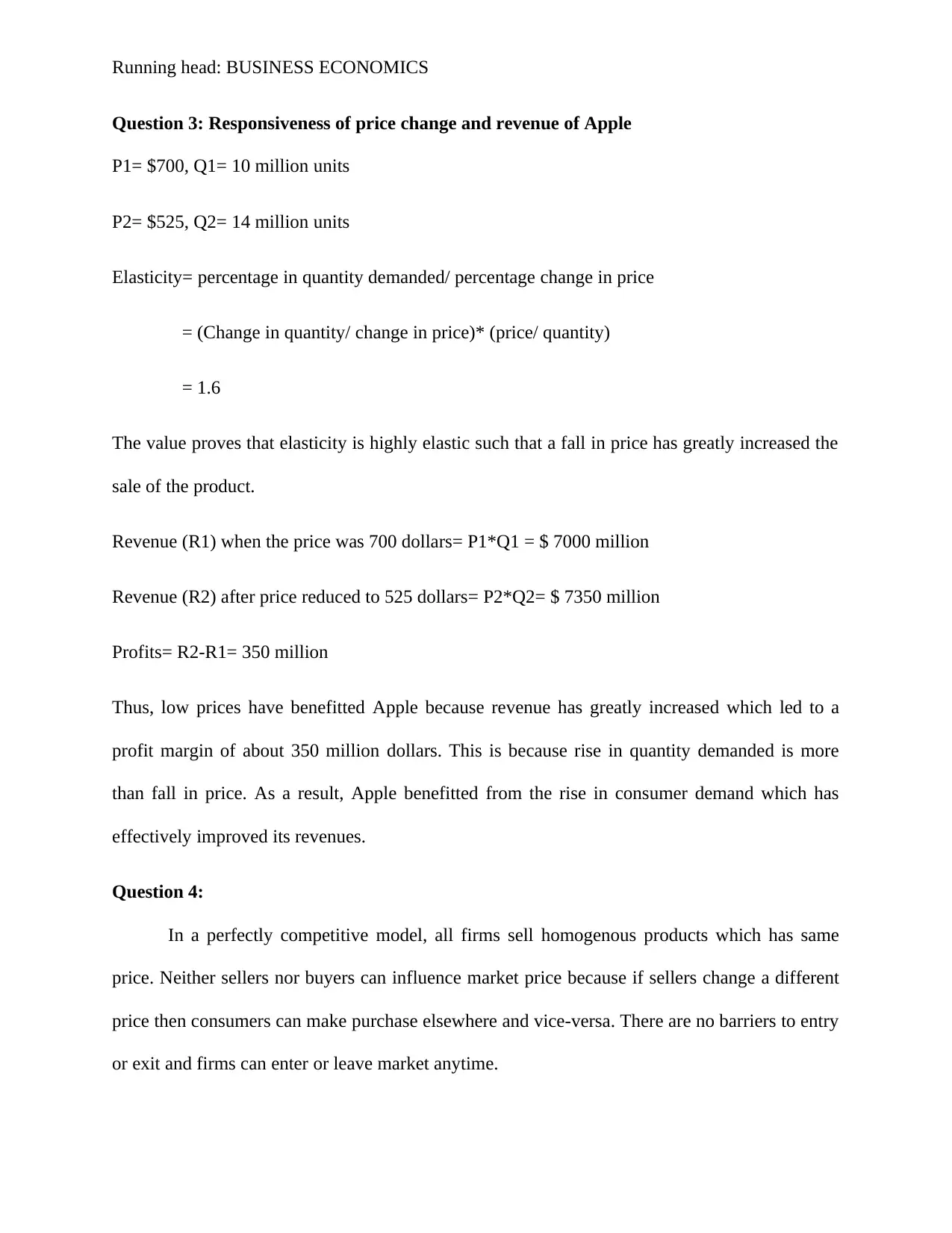
Running head: BUSINESS ECONOMICS
Question 3: Responsiveness of price change and revenue of Apple
P1= $700, Q1= 10 million units
P2= $525, Q2= 14 million units
Elasticity= percentage in quantity demanded/ percentage change in price
= (Change in quantity/ change in price)* (price/ quantity)
= 1.6
The value proves that elasticity is highly elastic such that a fall in price has greatly increased the
sale of the product.
Revenue (R1) when the price was 700 dollars= P1*Q1 = $ 7000 million
Revenue (R2) after price reduced to 525 dollars= P2*Q2= $ 7350 million
Profits= R2-R1= 350 million
Thus, low prices have benefitted Apple because revenue has greatly increased which led to a
profit margin of about 350 million dollars. This is because rise in quantity demanded is more
than fall in price. As a result, Apple benefitted from the rise in consumer demand which has
effectively improved its revenues.
Question 4:
In a perfectly competitive model, all firms sell homogenous products which has same
price. Neither sellers nor buyers can influence market price because if sellers change a different
price then consumers can make purchase elsewhere and vice-versa. There are no barriers to entry
or exit and firms can enter or leave market anytime.
Question 3: Responsiveness of price change and revenue of Apple
P1= $700, Q1= 10 million units
P2= $525, Q2= 14 million units
Elasticity= percentage in quantity demanded/ percentage change in price
= (Change in quantity/ change in price)* (price/ quantity)
= 1.6
The value proves that elasticity is highly elastic such that a fall in price has greatly increased the
sale of the product.
Revenue (R1) when the price was 700 dollars= P1*Q1 = $ 7000 million
Revenue (R2) after price reduced to 525 dollars= P2*Q2= $ 7350 million
Profits= R2-R1= 350 million
Thus, low prices have benefitted Apple because revenue has greatly increased which led to a
profit margin of about 350 million dollars. This is because rise in quantity demanded is more
than fall in price. As a result, Apple benefitted from the rise in consumer demand which has
effectively improved its revenues.
Question 4:
In a perfectly competitive model, all firms sell homogenous products which has same
price. Neither sellers nor buyers can influence market price because if sellers change a different
price then consumers can make purchase elsewhere and vice-versa. There are no barriers to entry
or exit and firms can enter or leave market anytime.
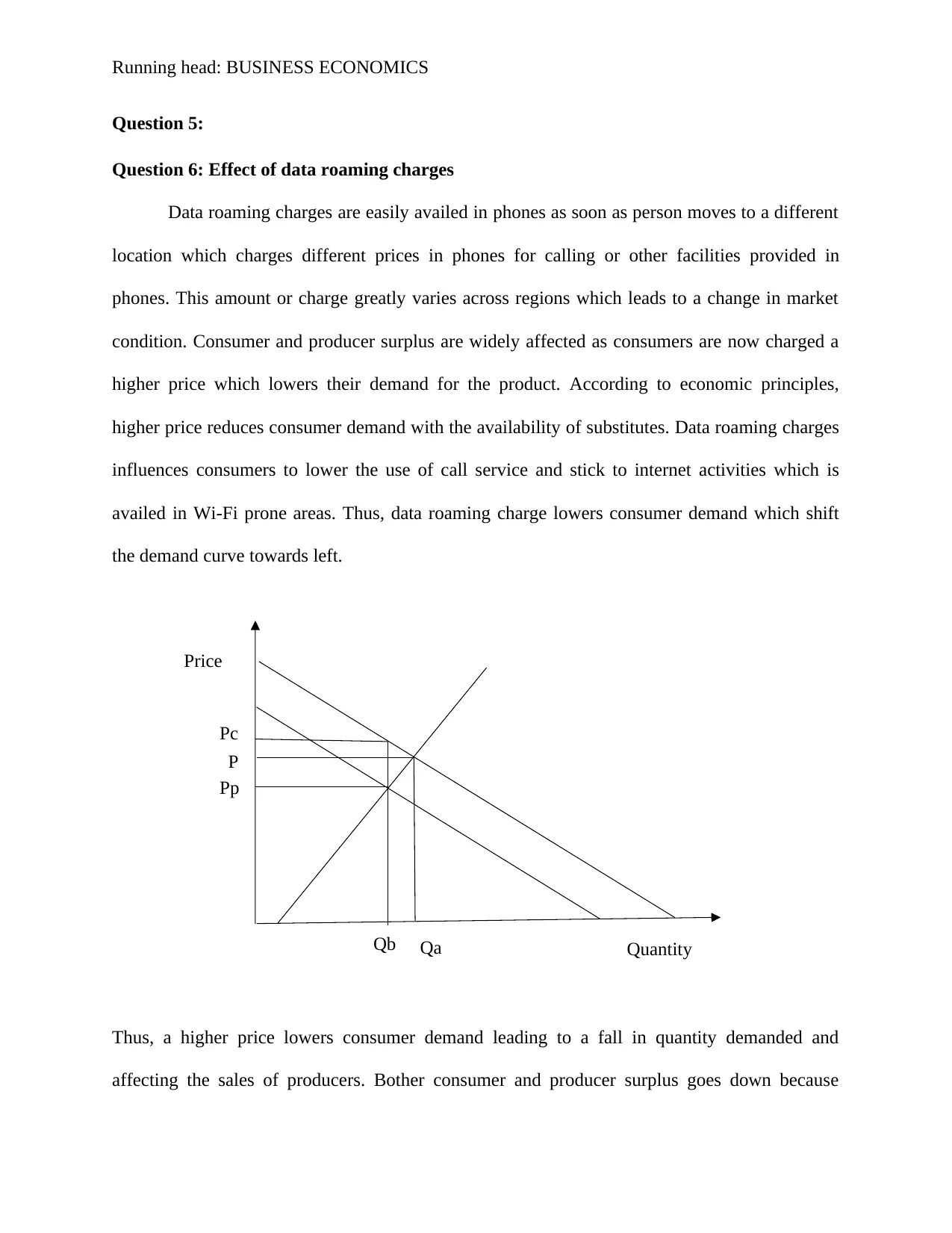
Price
Quantity
P
Pc
Pp
QaQb
Running head: BUSINESS ECONOMICS
Question 5:
Question 6: Effect of data roaming charges
Data roaming charges are easily availed in phones as soon as person moves to a different
location which charges different prices in phones for calling or other facilities provided in
phones. This amount or charge greatly varies across regions which leads to a change in market
condition. Consumer and producer surplus are widely affected as consumers are now charged a
higher price which lowers their demand for the product. According to economic principles,
higher price reduces consumer demand with the availability of substitutes. Data roaming charges
influences consumers to lower the use of call service and stick to internet activities which is
availed in Wi-Fi prone areas. Thus, data roaming charge lowers consumer demand which shift
the demand curve towards left.
Thus, a higher price lowers consumer demand leading to a fall in quantity demanded and
affecting the sales of producers. Bother consumer and producer surplus goes down because
Quantity
P
Pc
Pp
QaQb
Running head: BUSINESS ECONOMICS
Question 5:
Question 6: Effect of data roaming charges
Data roaming charges are easily availed in phones as soon as person moves to a different
location which charges different prices in phones for calling or other facilities provided in
phones. This amount or charge greatly varies across regions which leads to a change in market
condition. Consumer and producer surplus are widely affected as consumers are now charged a
higher price which lowers their demand for the product. According to economic principles,
higher price reduces consumer demand with the availability of substitutes. Data roaming charges
influences consumers to lower the use of call service and stick to internet activities which is
availed in Wi-Fi prone areas. Thus, data roaming charge lowers consumer demand which shift
the demand curve towards left.
Thus, a higher price lowers consumer demand leading to a fall in quantity demanded and
affecting the sales of producers. Bother consumer and producer surplus goes down because
⊘ This is a preview!⊘
Do you want full access?
Subscribe today to unlock all pages.

Trusted by 1+ million students worldwide
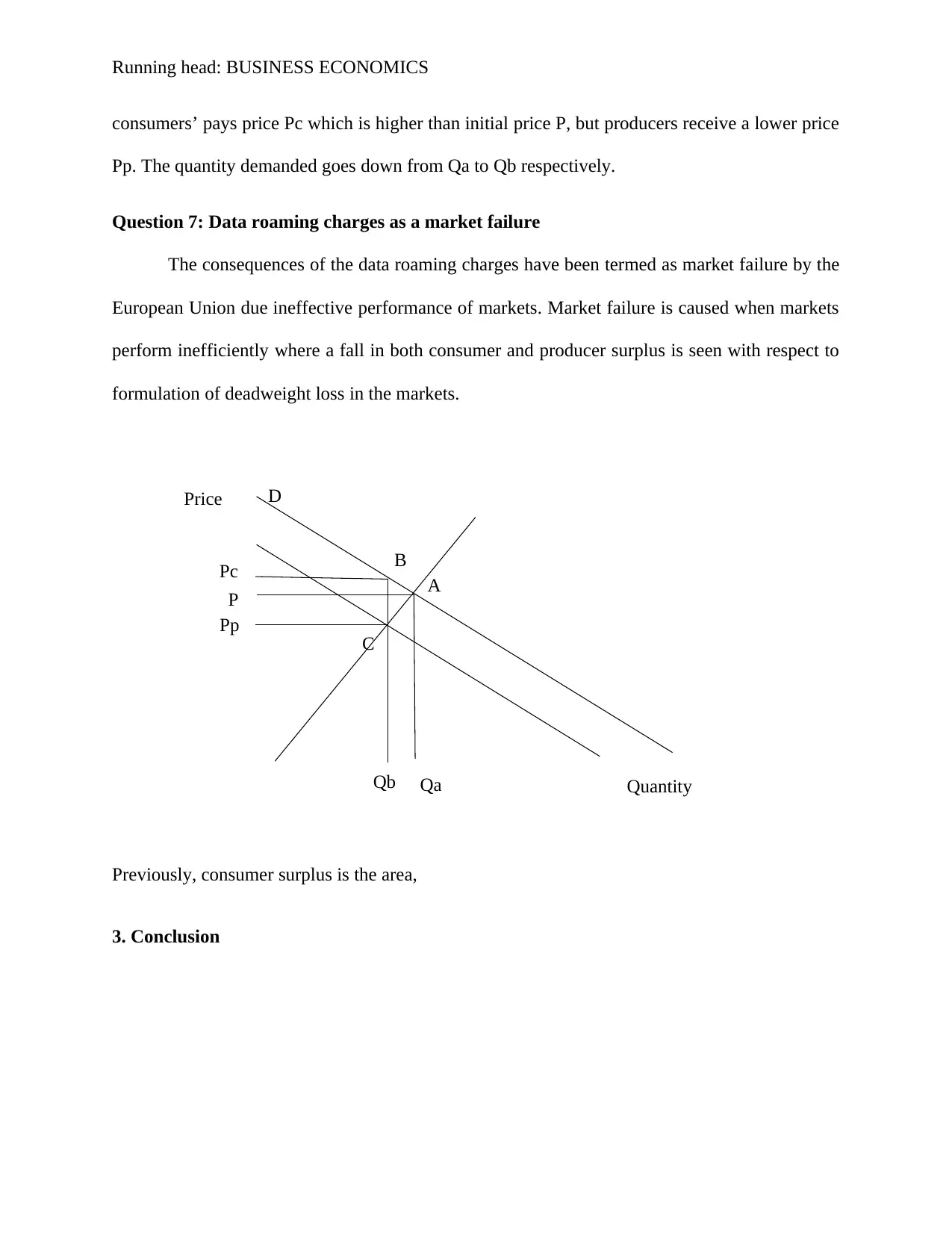
Price
Quantity
P
Pc
Pp
QaQb
A
B
C
D
Running head: BUSINESS ECONOMICS
consumers’ pays price Pc which is higher than initial price P, but producers receive a lower price
Pp. The quantity demanded goes down from Qa to Qb respectively.
Question 7: Data roaming charges as a market failure
The consequences of the data roaming charges have been termed as market failure by the
European Union due ineffective performance of markets. Market failure is caused when markets
perform inefficiently where a fall in both consumer and producer surplus is seen with respect to
formulation of deadweight loss in the markets.
Previously, consumer surplus is the area,
3. Conclusion
Quantity
P
Pc
Pp
QaQb
A
B
C
D
Running head: BUSINESS ECONOMICS
consumers’ pays price Pc which is higher than initial price P, but producers receive a lower price
Pp. The quantity demanded goes down from Qa to Qb respectively.
Question 7: Data roaming charges as a market failure
The consequences of the data roaming charges have been termed as market failure by the
European Union due ineffective performance of markets. Market failure is caused when markets
perform inefficiently where a fall in both consumer and producer surplus is seen with respect to
formulation of deadweight loss in the markets.
Previously, consumer surplus is the area,
3. Conclusion
Paraphrase This Document
Need a fresh take? Get an instant paraphrase of this document with our AI Paraphraser

Running head: BUSINESS ECONOMICS
1 out of 8
Related Documents
Your All-in-One AI-Powered Toolkit for Academic Success.
+13062052269
info@desklib.com
Available 24*7 on WhatsApp / Email
![[object Object]](/_next/static/media/star-bottom.7253800d.svg)
Unlock your academic potential
Copyright © 2020–2025 A2Z Services. All Rights Reserved. Developed and managed by ZUCOL.





